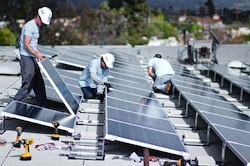According to a report from J.R. DeShazo, director of UCLA’s Luskin Center for Innovation, Los Angeles’ new rooftop solar energy program is delivering on its goal of cost-effective, clean power to thousands of electricity customers. The report also finds that the program should be expanded. Under the feed-in-tariff (FiT) program, electric power generated by solar rooftop installations on office and retail buildings, warehouses and apartment complexes is sold to the Los Angeles Department of Water and Power (LADWP) for use by its residential and business customers.
to the Los Angeles Department of Water and Power (LADWP) for use by its residential and business customers.
After numerous interviews with primary stakeholders, including solar developers and participating property owners, the UCLA researchers evaluated the initial two phases of the program, representing about 40 megawatts (MW) of solar power. These two allocations received a total of 256 program applications. Based on the rollout, the research team concluded that the “FiT 100” is on track to deliver 100 MW of carbon-free energy by 2015 – enough to power more than 21,000 homes annually.
The report also finds the program is on track to deliver on the jobs, economic and sustainability goals outlined when city officials approved the program in 2012. And the cost of power – averaging 15 cents per kilowatt-hour – is lower than any other similar FiT program in North America.
“The Los Angeles Business Council has been one of the strongest advocates for a viable feed-in-tariff program to produce 100 megawatts of solar electricity,” said L.A. City Council member Mitchell Englander. “Together the City of Los Angeles and the LABC have made great strides towards our efforts to reduce the City’s dependency on coal, moving away from centralized generation toward a more distributed model while creating thousands of local jobs in the process. Although the first and second tranches were successful, this study highlights an opportunity to make the process more user-friendly and cost-efficient in the future.”
In addition to clear environmental benefits, the installation of the first 40 megawatts is on course to generate 862 jobs, and the full 100 MW program is expected to create more than 2,000 jobs – 1,370 direct jobs plus 785 more indirectly related to the program, according to the UCLA study. The FiT 100 is also expected to deliver approximately $300 million in direct investment in the City of Los Angeles by solar companies and other businesses involved in the program. Once the full FiT 100 program is in place, the UCLA research team estimates that as many as 2.7 million tons of greenhouse gases will be displaced from the environment every year.
“Rooftops of office buildings, warehouses and apartments within the Los Angeles basin are proving to be outstanding sites for solar power plants,” according to Brad Cox, Chairman of the LABC Institute. “With about 10,000 acres of rooftops in Los Angeles, we think the sky is the limit for the solar FiT program.”
Also, the UCLA study suggests that the LADWP extend its FiT contracts from 20 to 25 years. Doing so will help the utility secure renewable energy for a longer time period, and assist solar developers in improving financing terms. The team also believes that greater awareness of the program would incentivize more building owners to make their rooftops available for solar projects.

